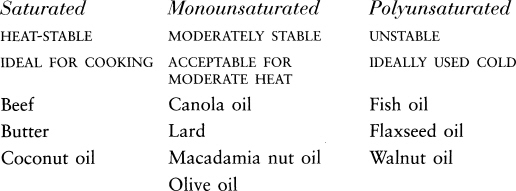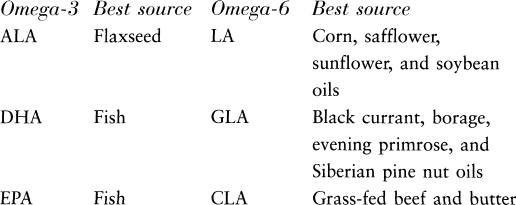Authors: Nina Planck
Real Food (21 page)
In the kitchen, some fats are appropriate for heating, others acceptable, and some unsuitable. Heavily saturated fats (which
tend to be solid at room temperature) are best for heating, monounsaturated fats are second best, and polyunsaturated fats
(liquid at room temperature) are ideally used cold. Fortunately, there is a traditional fat for every culinary need. For roasting
and sauteing, use butter, coconut oil, or lard, which are mostly saturated and monounsaturated. Chiefly monounsaturated oils,
such as olive and macadamia nut, are the next best choice for cooking. A good blend for sauteing is half butter, half olive
oil. Peanut and sesame oil, which contain more polyunsaturated fats, are less suitable for cooking but acceptable. In vinaigrettes
and other cold dressings, use flaxseed, olive, or walnut oil.
THE BEST COOKING FATS
Traditional cooking fats are saturated and thus heat-stable.

The body can manufacture some fats, while others, called
essential,
must be found in foods. The essential fats are polyunsaturated omega-3 (best found in fish) and omega-6 (vegetable oils).
They have equally important, but opposite effects in the body. Ideally, the diet contains equal amounts of omega-3 and omega6
fats, but the typical American eats too few omega-3 and too much of the main omega-6 fat, which leads to inflammation, obesity,
diabetes, heart disease, cancer, and depression.
Omega-3 fats include alpha-linolenic acid (ALA), docosahexaenoic acid (DHA), and eicosapentaenoic acid (EPA). Flaxseed oil,
grass-fed beef and butter, and pastured eggs all contain some omega-3 fats, but the best source is fish. The main omega-6
fat is linoleic acid (LA), found in grain and seed oils such as corn, safflower, and soybean oil. Once rare in the diet, the
omega-6-rich oils are now ubiquitous, especially in junk food, and we eat too many.
Gamma-linolenic acid (GLA) and conjugated linoleic acid (CLA) are two omega-6 fats we should eat more of because they tend
to behave like omega-3 fats in the body. In theory, the body can make GLA from the LA in corn oil, but the conversion is inhibited
by many factors, so in practice the best sources are the oils of borage, black currant seed, evening primrose, and Siberian
pine nuts. GLA treats premenstrual problems, reduces inflammation, dilates blood vessels, reduces clotting, and aids fat metabolism.
CLA, which fights cancer and builds lean muscle, is found almost exclusively in grass-fed beef and grass-fed butter.
THE ESSENTIAL FATS
The essential fats must be eaten in the right quantities. The industrial diet contains too much LA from vegetable oils, which
leads to inflammation, obesity, diabetes, and heart disease.

Each fat has different nutritional qualities thanks to its particular fatty acids. For example, butter contains saturated
lauric acid, which fights viruses. Lard and olive oil contain monounsaturated oleic acid, which lowers LDL. Any fatty acid
(such as oleic acid) is chemically identical whether it's from lard or olive oil, and has the same effect in the body.
With animal fats, the breed and especially the animal's
diet
affect fatty acid composition and nutritional value. In other words, all beef fat is not identical. Grass-fed beef contains
more polyunsaturated omega-3 fat and more CLA than grain-fed beef. Grass-fed cream contains more beta-carotene, vitamin A,
and CLA than cream from grain-fed cows. Lard from pigs that eat coconut contains more saturated lauric acid than lard from
pigs that eat acorns.
The nutritional value of vegetable oils, on the other hand, is affected by how the oil was
processed.
Refined vegetable oils such as corn and soybean oil are pressed under high heat. Vitamin E is destroyed, and delicate polyunsaturated
fats are oxidized. In extra-virgin olive oil, the antioxidants and vitamin E remain intact. Polyunsaturated oils, such as
walnut and flaxseed, should be cold-pressed.
This is the most important thing about the nutrition of fats.
All the traditional
fats
—
ideally
unrefined
—
are healthy in
moderation.
The body needs all three kinds of fats (saturated, monounsaturated, polyunsaturated) for various purposes, from pregnancy
to digestion to thinking.
Aren't some fats unhealthy? Yes. It's easy to remember the bad ones: they are the industrial fats recently added to our diet.
The unhealthy fats are
refined vegetable oils,
including corn, safflower, sunflower, and soybean oil, and synthetic
trans fats.
Trans fats are formed by hydrogenation, in which unsaturated oils are pelted with hydrogen atoms to make an artificially saturated
fat. That's how they make firm margarine from liquid corn oil. Like natural saturated fat, hydrogenated oils are solid at
room temperature and shelf-stable, which makes them useful for processed foods and baked goods. But trans fats lower HDL and
cause heart disease, among other maladies. Industrial vegetable oils are unhealthy because they are too rich in omega-6 fats
and because they are typically refined with heat, which makes them rancid and carcinogenic.
I've done my best to heed my friends' plea for brevity and greatly simplified the complex chemistry of fats. But the moral
of the story is simple. If you're trying to remember which fats are healthy, follow this rule:
eat the foods we've eaten for thousands
of years in their natural form.
If you can't find the perfect version of a food— say, 100 percent grass-fed beef— look for the next best thing. Any version
of the traditional fats will be better for you than any version of the industrial fats. Those you must avoid like the proverbial
Black Death.
TRADITIONAL AND INDUSTRIAL FATS
The
Basics
• All the traditional fats are healthy
• The industrial diet contains too many omega-6 fats and too few omega-3 fats. This leads to obesity, diabetes, heart disease,
cancer, and depression
• Trans fats lower HDL and cause heart disease, among other ills
• With animal fats, the animal's diet matters for our health
• With vegetable oils, processing matters for our health
Traditional Healthy Fats: Eat Up
ANIMAL FATS
• Fat from grass-fed cattle, sheep, bison, and other game
• Butter and cream from grass-fed cows
• Lard from pastured pigs fed a natural diet (pigs eat anything, so their diet varies)
• Egg yolks from pastured chickens, ducks, and geese
• Fish oils (preferably wild), especially cod-liver oil
VEGETABLE OILS
• Cold-pressed, extra-virgin olive oil
• Cold-pressed, unrefined flaxseed oil
• Wet-milled, unrefined coconut oil
• Cold-pressed, unrefined macadamia nut oil
• Cold-pressed, unrefined walnut oil
• Cold-pressed, unrefined sesame oil
Modern Industrial Fats: Avoid
• All hydrogenated and partially hydrogenated oils, including lard and all vegetable oils
• Corn, safflower, sunflower, and soybean oils, especially when refined or heated
How I Stopped Worrying and Learned to Love Saturated Fats
AT BONNIE SLOTNICK'S, a wonderful Greenwich Village bookshop, I was hunting for clues to the traditional American diet as
if they were pottery shards, when Bonnie showed me
Twenty
Lessons in Domestic Science,
a slim book billed as a "condensed home study course." It sold for two dollars in 1916, but I was happy to pay fourteen dollars.
Twenty Lessons
presents the food groups, nutritional information, recipes, and "Hints for the Housewife." "Make a business of your kitchen,"
it says, "and run that business as carefully as does the merchant who sells you your food." Very sensible.
All-but-forgotten frugality is not what I find curious about old nutritional primers. They illustrate just how dramatically
the American diet has changed and how fast. In
Lesson No. 1: The
Composition of Food Materials,
a government "Expert in Charge of Nutritional Investigations" at the U.S. Department of Agriculture provides nutritional information
on meat, dairy, fish, grains, and other foods. It was the sketch of fats and oils that stood out; only five were mentioned:
bacon, lard, beef suet, butter, and olive oil. In 1916, these were the fats we ate. Not anymore.
A child of my times, I once steered clear of saturated fats. Most people, and most doctors, would have regarded my diet and
habits as stellar. In those days, I ate a lot of fish, vegetables, and olive oil; I was a runner and got plenty of sleep.
But my digestion was poor, and I was often laid low by colds and the flu. Today my complaints are gone, I rarely get sick,
and I feel great. The only change is eating saturated fats every day.
Perhaps you're like me a few years ago, and you've never heard a good word about "artery-clogging" saturated fats. Actually,
they are vital to health. The most basic function of saturated fats is structural: they make up half of cell membranes. The
site of all chemical activity in the body, the cell is a barrier to unwanted substances and a gateway to good ones, and the
cell membrane is an extremely fine tool. A human hair is eighty thousand nanometers wide. (One million nanometers make a millimeter.)
By comparison, the cell wall is tiny: only ten nanometers thick. It needs exactly the right degree of flexibility and permeability:
neither too stiff nor too floppy, neither impenetrable nor too porous. Saturated fats provide stiffness, unsaturated fats
flexibility.
Certain saturated fats (short- and medium-chain fatty acids) are easy to digest because they do not have to be emulsified
first by bile acids, as long-chain polyunsaturated fats do. These saturated fats (in butter and coconut oil) are used directly
for energy, rather than stored as fat. Saturated lauric acid in coconut oil actually increases metabolism.
Saturated fats are required for the absorption of calcium and other minerals. When the diet contains saturated fats, the body
is better able to retain the vital long-chain polyunsaturated fats, such as the omega-3 fats in fish.
4
Saturated fats also build immunity by fighting harmful microbes, viruses, and other pathogens, especially in the digestive
tract. Saturated lauric acid destroys the HIV virus.
Maybe you aren't convinced. Saturated fats may fight infections, but what about heart disease? Here again, I found surprises.
Saturated fats lower blood levels of lipoprotein (a) (Lp(a)), which leads to clotting and atherosclerosis. Even the fats around
the heart muscle are saturated.
5
They include stearic acid, found in beef and chocolate, and palmitic acid, in coconut oil, palm oil, and butter.
6
What about the "fatty" plaques in arteries that can burst and cause heart attacks? Fat is only one part, often a small one,
of such plaques.
7
.
Moreover, only 26 percent of the fat in arterial plaques is saturated.
8
The rest is unsaturated, of which more than half is polyunsaturated.
The cholesterol theory says that eating saturated fats raises blood cholesterol in unhealthy ways. The truth is more complicated.
First, about half of blood cholesterol has nothing to do with diet. Second, when you eat too much saturated fat, the body
converts it to monounsaturated fat, which lowers LDL and leaves HDL alone.
9
Furthermore, certain saturated fats (palmitic and stearic acid) have a neutral or beneficial effect on cholesterol. Forgive
me for mentioning stearic acid again; perhaps I've grown partial to it because I'm fond of chocolate, but it kept turning
up in my reading. Stearic acid makes a curious case study in the history of fats.
Ancel Keys, an early proponent of the cholesterol theory, made the Mediterranean diet, featuring fish, vegetables, olive oil,
and REAL FATS 177 red wine, famous in the 1950s and '60s. Keys developed predictive equations on diet and cholesterol. Most
of his calculations, which were influential, showed that saturated fat raised cholesterol more than polyunsaturated fat, as
he expected. Keys also found that stearic acid did
not
raise cholesterol, a detail he ignored. Later, other research confirmed the neutral or positive effect of stearic acid on
blood cholesterol, especially the ratio of HDL to LDL. The National Research Council's report
Diet and
Health
and the surgeon general's
Report on Nutrition and Health
both noted that stearic acid did not raise cholesterol. In 2005, the journal
Lipids
wrote: "Stearic acid lowers LDL cholesterol."
10

